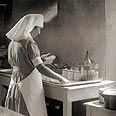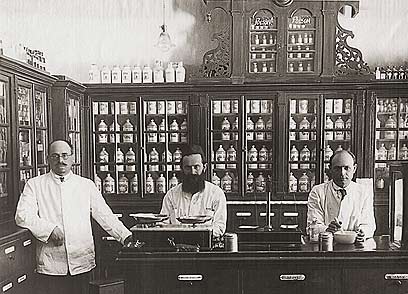
Exhibition shows Hadassah's early years
Photo exhibition at Jerusalem Theater gives visitors look into beginnings of medical system in Israel, from Rothschild hospital to opening of infant welfare centers to pictures of Hadassah today
A new exhibition, displayed till the end of August in the lobby of the Jerusalem Theatre, presents the Hadassah association's part in laying the foundations for medical and social institutions in Israel. The exhibition shows photographs from the start of the 20th century up to the 1950s, taken from Hadassah Medical Center's archives, and gives visitors a peak at how the medical system was run at the time.
The beginning: Public clinic in Jerusalem
The Women's Zionist Organization of America convened during Purim 1912 and decided to name its new organization Hadassah, the Hebrew name of Queen Ester.
A year later two American nurses were sent to the Land of Israel on behalf of the Hadassah Women's Zionist Organization of America, funded by philanthropist Nathan Strauss. They opened a public clinic in Jerusalem, and were followed by a large medical delegation that opened a nationwide chain of hospitals, clinics and educational institutions.

Delivering milk to needy mothers in Jerusalem's Old City
The organization's work was put on hold during the First World War, and was resumed in 1918. Rothschild hospital on Hanevi'im Street in Jerusalem (now know as Hadassah College Jerusalem) was selected as Hadassah's main center in Israel.
Simultaneously, community services, clinics and hospitals were opened across the country, including in Jaffa, Tel Aviv, Haifa, Tiberias and Safed.
In 1934 the second Hadassah hospital was opened, on Mount Scopus. On April 13, 1948, a convoy on its way to the hospital from central Jerusalem was attacked. Seventy-eight of its passengers were killed, including Hadassah Director Dr. Haim Yassky. After the incident, it was decided to evacuate the hospital, and only in 1976, after it was renovated, did the hospital resume operation.
Tens of thousands of photos in boxes
The decision to launch the exhibition was made by curator Edna Guggenheim, some two years ago, when she came into possession of boxes containing tens of thousands of photographs from the Hadassah organization's earlier days.

Pharmacy at Rothschild hospital in Jerusalem
"When we got the photographs, some two years ago, we decided to organize them and computerize them," she said. "While we were organizing them, we came across pictures that were taken by the best photographers of the time, which showed how the medical system in Israel worked, and we decided that this should be shared with the general public."
How did you choose with photos to include in the exhibition?
"This was our biggest problem," said Guggenheim. "Since I worked on the project with another friend, we decided that each of us should choose what we think is suitable and all the pictures we selected, 80 in all, were presented to the people who work at Hadassah and people from the outside, to give their opinion, and this is how we decided."
The exhibition, said Guggenheim, demonstrates the Hadassah organization's part in building the medical system in Israel. "The exhibition starts at Rothschild hospital," Guggenheim said. "It then moves to the hospital on Mount Scopus and its desertion, following the War of Independence. Then, Hadassah's involvement in the construction of infant welfare centers can be seen, as well as a documentation of the operating rooms of that time and nursing and medical schools. The exhibition ends with photographs from Hadassah today."
The exhibition, “The Healing of the Daughter of My People – Hadassah, the Early Years,” will be displayed at the Jerusalem Theater's lobby until Tuesday, August 31.
- Follow Ynetnews on Facebook










